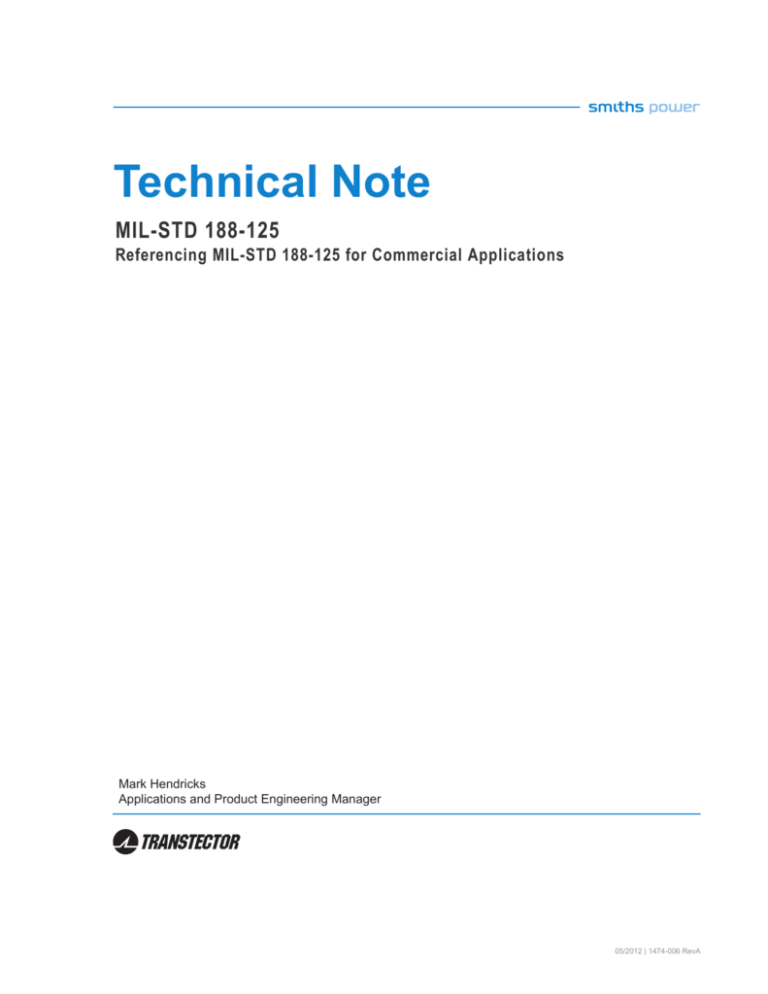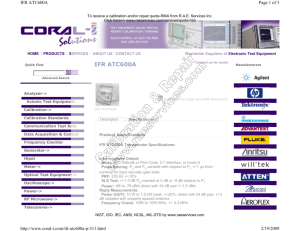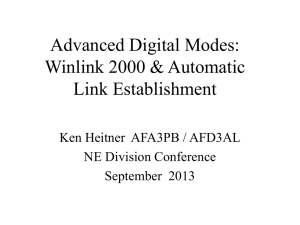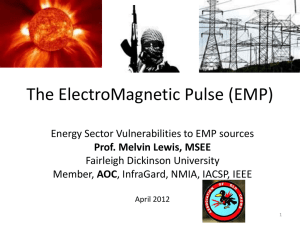
Technical Note
MIL-STD 188-125
Referencing MIL-STD 188-125 for Commercial Applications
Mark Hendricks
Applications and Product Engineering Manager
05/2012 | 1474-006 RevA
Technical Note | Referencing MIL-STD 188-125 for Commercial Applicants
Referencing MIL-STD 188-125 for Commercial Applications
Electromagnetic Pulse (EMP) is an intense electromagnetic field that can instantly overload electrical
circuits and damage microelectronics, electrical control and communications systems as well as electric
power distribution networks. Produced in the atmosphere by the gamma ray pulse of a nuclear explosion,
it is referred to as High-Altitude Electromagnetic Pulse (HEMP) or Nuclear Electromagnetic Pulse (NEMP),
which affects electronic equipment over a wide area. Other sources of EMP include nuclear explosions
on the ground, man-made weapons like High Power Microwave (HPM) or Directed Energy Weapons
(DEW) as well as natural causes like solar storms and lightning.
The widespread, detrimental effects of an EMP/HEMP event are well understood and recognized
within military theaters. To protect critical systems, the US military established a comprehensive set
of standards. MIL-STD 188-125-1 and -2 in particular describe the threat environment, test methods
and minimum protection requirements for high-altitude electromagnetic pulse (HEMP) hardening of
fixed and transportable ground-based facilities which perform critical, time-urgent command, control,
communications, computer, and intelligence (C4I) functions.
Since any environmental effects of an EMP/HEMP event would also expand to the civilian infrastructure,
the International Electrotechnical Commission attempted to establish a civilian set of standards resulting
in IEC61000-1. While the military standard provides definitive limits for electric free field shielding and
pulse current injection testing, the IEC standards generally use electric system disruption as a pass fail
criteria.
Due to the extensive detail, highest performance requirements and credibility of the originating authority,
MIL-STD 188-125 has become the most widely respected and referenced EMP/HEMP protection standard
around the world. Nevertheless, proper application of this standard for non-US military applications
is severely misunderstood. This paper emphasizes the purpose of MIL-STD 188-125 and explains its
correct use for commercial or non-US military applications in an economically feasible way.
MIL-STD 188-125 – Purpose
MIL-STD 188-125-1 and -2 describe the threat environment and protection requirements for absolute
critical command and control applications with no margin for disruption of command chain communications.
These tests are severe and the pass requirements are conservative in the extreme. After all, this standard
is intended to preserve the executive chain of command of the US armed forces. While the standards are
under the responsibility of the US Defense Threat Reduction Agency (DTRA), the actual implementation
falls within the governance of the US Strategic Command - operational and survivability branch of the
US Armed Forces. Facilities regarded as critical command and control assets required to comply with
the provisions are identified by the Joint Chiefs of Staff, Military Department Headquarters, or a Major
Command.
US military suppliers of equipment classified as critical per MIL-STD 188-125 have to comply with all
provisions as applicable.
MIL-STD 188-125 – Application to Non-US Military Situations
The complexity of the provisions of MIL-STD 188-125 requires considerable investment in time and
resources to understand and apply each one. Achieving full protection can quickly become an expensive
endeavor. To keep financial expenses in check, many businesses and organizations referencing
05/2012 | 1474-006 RevA
MIL-STD 188-125 thus consider not applying it in its entirety but attempt to extract the most important
aspects. However, MIL-STD 188-125 is not a pick-and-choose menu. To effectively protect a system
from EMP induced damages, the complete standard must be applied. Skipping critical shielding or filter
investments could compromise the entire shelter environment.
Despite the stipulation of having to apply the standard in its entirety, it is possible to do so in an economically
feasible way. As discussed earlier, MIL-STD 188-125 is designed for facilities that perform critical, timeurgent functions. This is an important aspect as it allows for scalability. For a business, the entire facility
may not be critical, but instead only specific systems or servers that may fit into a room or even box. In
addition, it needs to be determined whether the system needs to operate through an EMP/HEMP event
or if it can accept brief disruptions as long as it can return to normal service after the event. System
designers are encouraged to identify the core service or key asset that must be protected and build it into
a fully compliant EMP vault at a small scale.
Conclusion
MIL-STD 188-125 has been designed to protect critical communications systems from HEMP damage
in the most extreme environments under the most severe conditions. As such, it is an authoritative
reference for any agency or organization looking to safeguard its communication structure and assets. To
effectively protect a system, the standard has to be applied in its entirety. Despite its complexity, doing so
can be accomplished in an economically feasible way by scaling the protection efforts down to the most
critical assets of a system.
© Smiths Power 2013. All Rights Reserved.
Technical Note | Referencing MIL-STD 188-125 for Commercial Applicants
Appendix
Summary of Sections
The MIL-STD 188-125 -1 and -2 documents for fixed and transportable ground-based facilities are divided
into three main parts: definitions, requirements and test procedures.
The definitions in part one provide a solid base of terms and descriptions to support further discussion,
design and construction. Part two, General and Detailed requirements, provides a foundation to build an
understanding of shielding and filter principles upon which to execute the actual construction of the HEMP
facility. The Test section establishes baseline requirements that allow pass/fail conclusions and unbiased
decisions to determine whether or not the system is adequately shielded. Three test procedures are
documented: A-Shielding Effectiveness, B-Pulse Current Injection and C-Continuous Wave Immersion.
The differences between MIL-STD 188-125-1 and -2 manifest in grounding and Pulse Current Injection
limits. While the necessity of bonding all metallic construction does not change, mobile applications are
not always connected to Earth. With fewer connections to fixed AC power and long haul land lines, the
pulse current injection severity is reduced by approximately half for mobile applications. Test requirements
and residual let-through limits are summarized in the appendix. Note that the difference in Pulse Current
Injection limits for MIL-STD 188-125-1 versus -2 demonstrates the lower injection requirements for mobile
applications.
MIL-STD 188-125 does not include any references towards conducted insertion loss testing. These tests
are necessary to properly characterize a filter and can be found in MIL-STD 461 and MIL-STD 220.
Engineers are reminded that MIL-STD 188–125–1 and -2 are based on free field EMP environments
produced from the gamma rays and Compton effects from high-altitude nuclear detonation. These free
fields, which can reach strengths of up to 50 kV/m, induce currents and voltages into electrical systems
but tests described in the standard do not measure conducted insertion loss.
MIL-STD 188-125 also offers the option of installing special protective measures in place of complete
adherence to the shielding effectiveness and pulse current injection testing protocol. This means
alternative protection solutions are acceptable if they meet test requirements and offer enough protection
to maintain system operation.
Please contact us for questions or further information on this topic.
Contact:
Tel: (+1) 208-772-8515
Email: Sales@ProtectionGroup.com
www.protectiongroup.com
05/2012 | 1474-006 RevA








